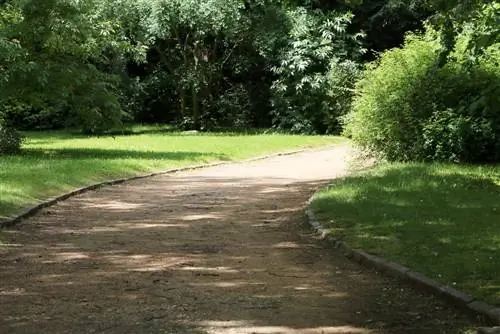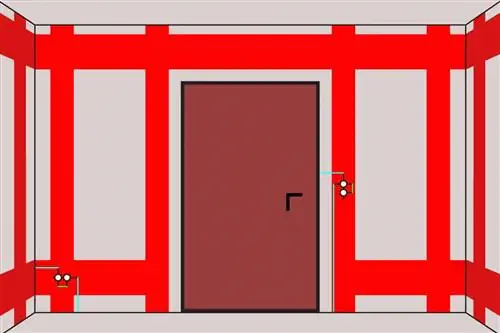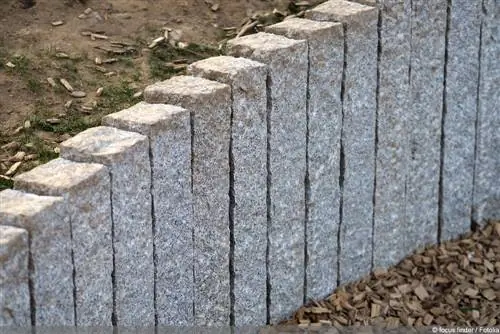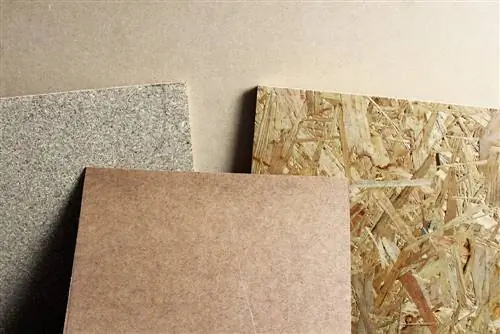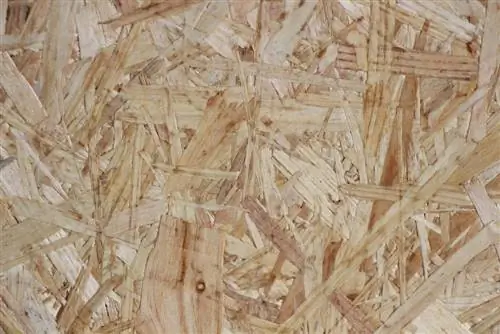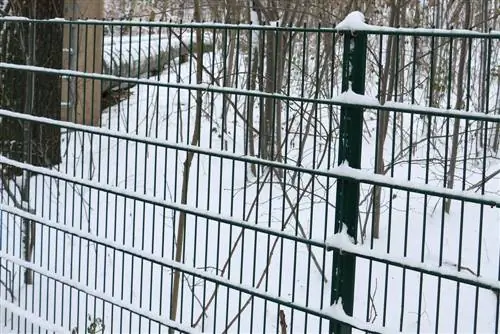- Author admin [email protected].
- Public 2023-12-17 03:39.
- Last modified 2025-06-01 06:48.
Lawn borders keep the grass decoratively and practically under control and make it easier to create accurate paths and grass-free beds. How they are set and which dimensions and weights are available is revealed here, as well as the prices for the lawn edge stones and possible alternatives to the classic solid and rectangular shape.
Material
Setting a lawn border is easy in itself, but requires appropriate accessories in addition to the lawn edging stones themselves. This includes:
- Concrete
- Board
- Thread and sticks
- Fine gravel
- Rubber mallet or hammer and board
- Spade
- Spirit level
- Inch rule
These aids and tools are necessary to be able to set the lawn borders straight and safely without damaging the stones.
Instructions
If solid lawn borders made of stone or concrete are to be set, various steps are required. The process is as follows.
- Stretch a string along the desired lawn edge as a guide and dig a narrow trench under this guide. For additional help, a board can also be placed on the ground to create a straight edge and make digging the trench easier. The trench should be about three times as wide as the lawn borders and about a third to half the height of the lawn borders. Using the ruler you can easily check whether the depth of the trench is even.
- The inside of the trench is compacted with a board, strip or bricks - depending on the width of the trench. To do this, a straight tool is inserted and lightly tapped with a hammer or stone so that the surface of the earth is as flat as possible.
- Crete or fine gravel can now be filled into the trench. Concrete should be used when setting heavy and high lawns as it provides a more stable base. Gravel is sufficient for low and light lawn borders, but even then it does not offer guaranteed protection against the stones tipping over - for example if the lawnmower is accidentally driven against them.
- The grass borders are now inserted into this bed made of concrete or gravel. Again, the string should be used as a guide to allow for straight alignment. The spirit level is used to check the horizontal alignment. If necessary, the lawn edging stones can be driven deeper into the still wet concrete or gravel using a rubber mallet or a board and an ordinary hammer.
- If the lawn edging stones are aligned as desired, the side of the trench can be filled with concrete or gravel to give the borders further stability. The top cover can be made of gravel or earth depending on the visual preference. When covering with soil, care should be taken to ensure that the height is appropriate so that the lawn can finally grow up to the border.
Tip:
Lawn borders with tongue and groove can be easily aligned as the stones interlock and are therefore more stable when placed in a row.
Dimensions
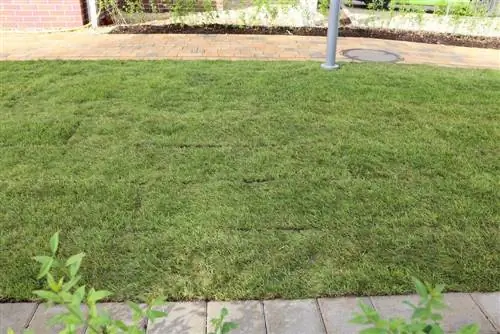
Classic lawn borders made of stone or concrete usually have lengths of 50 or 100 centimeters. However, the length dimensions may differ for corner stones or angles. There is more flexibility when it comes to height. 15, 20, 25 and 40 centimeters are common. A similarly large spectrum can be found in terms of width and depth. The usual sizes range from narrow 1.5 centimeters to 5 and 6 centimeters to wide 8 or even 10 centimeters. However, there are also other dimensions in the large selection.
In addition to the appearance, the intended use is also crucial when choosing. If a bed with taller plants is to be separated from the lawn or if the boundary surrounds an elevated path or a gravel path, higher lawn borders make sense. If it's just a matter of bordering the lawn from a stone path or a low bed, low lawn borders are sufficient. These also represent less of a tripping hazard - but are also easier to "run over" with the lawnmower.
Weights
The weight of a lawn border stone obviously depends on the dimensions and the material. A concrete lawn board with a thickness of 5 centimeters, 25 centimeters high and 100 centimeters long weighs around 30 kilograms. However, if the lawn board is made of granite, the weight can be 40 kg or more with the same dimensions.
The heavier the lawn borders are, the more stable the base must be to prevent the stones from sinking. In addition, heavy lawn edging stones are harder to set and the effort and costs for transport are increased.
Prices
The price for lawn borders depends on the dimensions and material as well as the number and transport. Narrow, small concrete lawn borders are available for less than two euros. Variants made of concrete with tongue and groove, in larger dimensions or decorative colors usually cost less than five euros. Matching corner or angle stones are a little more expensive.
Here are some concrete examples from the OBI hardware store:
- Gray concrete lawn borders, 100 x 25 x 5 cm - 1.59 EUR
- Matching corner stone made of gray concrete, 25 x 25 x 5 cm - 6.49 EUR
- Brown concrete lawn borders, 100 x 25 x 5 cm - 2.29 EUR
- Matching corner stone made of brown concrete, 25 x 25 x 5 cm - 7.29 EUR
For a lawn border in gray, you only have to pay 1.59 euros per meter. However, if the concrete lawn edge is to be brown, it is at least 2.29 euros per running meter. For a rectangular shape, the gray version costs an additional 25.96 euros for corner stones. For the brown version, however, 29, 16 euros.
Completely different price ratios can be found for lawn borders made of granite or other natural stone, with granite being the most common alongside concrete. There are no lawn borders available here for less than ten euros. The upper spectrum - for example for very large widths or special colors - ranges between 50 and around 70 euros per straight lawn edging stone.
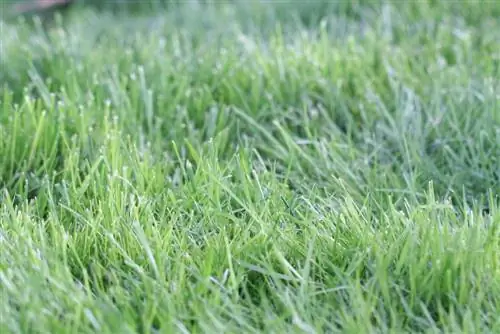
For your orientation, here are some concrete price examples for lawn borders made of granite and other natural stone:
- Granite, gray, 100 x 20 x 8 cm at Hornbach - 15.49 EUR
- Granite, gray, 100 x 25 x 8 cm at Baywa Baustoffe - 30, 70 EUR
- Granite, gray, 100 x 40 x 10 cm at Steinhandel24 - 59.25 EUR
- Hard stone, black, 100 x 25 x 8 cm at Steinhandel24 - 65, 45 EUR
- Bas alt, black, 100 x 25 x 8 cm at Naturstein-online-buy - 45.95 EUR
Some suppliers give a discount if larger quantities are ordered. Of course, this discount is only interesting if a corresponding scope is to be defined. The delivery costs usually have to be added to the price. Due to the weight, delivery is usually handled by a shipping company. Alternatively, vans can be rented from hardware stores or a delivery can be booked for purchase. Depending on the number of lawn borders and the choice of transport, you can expect to pay at least 50 to 100 euros. There are also costs for concrete, gravel and, if necessary, other aids.
Alternatives
Lawn borders made of stone or concrete are stable and durable, but they also require some effort when setting. If you want to avoid this, you can use other alternatives. For example on:
- Flexible metal lawn edges
- Plastic lawn edges
- Round palisades made of plastic, wood or concrete
- Bed borders
Setting these variants requires significantly less effort, as most alternatives have simple plug-in devices. An exception here are flexible lawn edges made of sheet metal. Since they have thin, sharp edges, a separate plug-in device is unnecessary. So they are stuck directly into the ground, there is no need to dig a trench and pour in concrete or gravel.
They also offer the advantage of being able to create more flexible shapes. This means that beds can be semicircular or round in the lawn or the lawn edge can be finished in a wave shape. In terms of price, there are again significant differences. However, the high costs for delivery with a shipping company and the necessary aids are eliminated.

